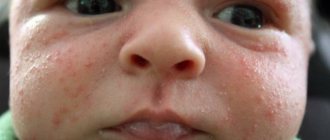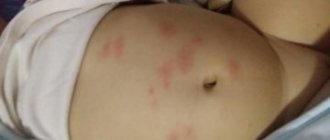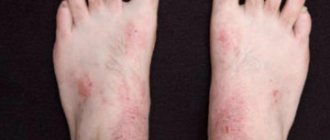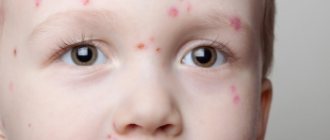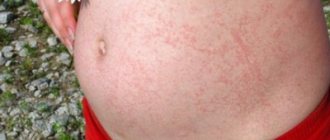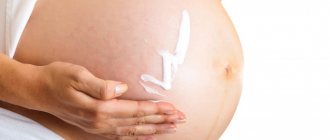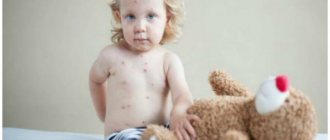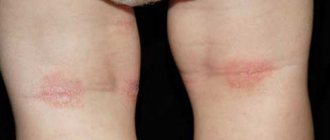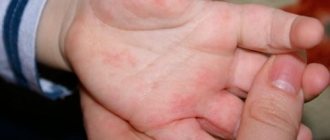A rash on the stomach and back of a child may indicate a number of changes that occur in the functioning of internal organs and systems. The rashes themselves can be of a different nature and differ in the provoking factor. Moreover, they appear at the most inopportune moment in representatives of all age groups. What provokes the problem, how to deal with it and prevent the progression of complications - everything in order.
What kind of rash happens?
There are many types of rashes that occur on the abdomen, neck, chest, back, butt, groin, arms and legs, chin and around the mouth.
To determine the reason for these pimples, you need to contact your pediatrician. Only he will be able to clearly determine what kind of rash the child has and how to deal with it.
Main types of rashes:
- Infectious rash.
- Miliaria (red rash).
- Allergic reaction.
- Dermatitis (contact, atopic, diaper).
- A rash that appears as a result of taking medications.
- Neonatal rash on legs.
Causes
All types of rashes can be divided into two main groups: hormonal and allergic. Let's look at the causes of the rash in each case.
Manifestation of allergies
Allergic rashes are most common among infants. There can be many reasons for its appearance.
- The mother wants to diversify her child’s diet and tries to constantly add something new to it. Of course, it’s worth doing this, but gradually. If you introduce a new product, wait for the baby’s body’s reaction to see whether redness appears in the mouth or not. Only after this can you try something else.
- Often, pimples on the back may appear after a massage using baby creams and oils. Carefully study their composition, they may contain allergens. Only when you are sure that the baby is not allergic to the components can you use the purchased massage products.
- If your child is breastfed and develops a small red rash around the mouth and neck, this is a reaction to the baby formula.
- Introducing complementary foods too early. An allergy around the mouth can be a signal to parents that the child’s body is not ready for new foods.
Hormonal rashes
Acne is very common in young children, especially in the first few weeks after birth. Most often, a hormonal rash can be seen on the baby's neck, on the cheeks and under the hair. It is important to know that these spots on the skin are not dangerous and do not expose other people to the risk of infection.
The simplest hygiene rules will help you get rid of the problem. If after a few weeks of following them the spots do not go away, it is recommended to consult a dermatologist, he will prescribe special ointments. After them, everything can go away the very next day.
Types of rash
Skin rashes in a child can be of different types. After determining what is needed, the reasons for its occurrence are identified.
Red spots
- Hyperhidrosis. A red rash in infants is not uncommon. It appears when the body is severely overheated. The vessels become clogged, preventing air from circulating. As a result, pimples and small rashes form on the neck and butt, on the legs under the knees and in the armpits, on the chin and around the mouth, and in the groin. Frequent showers and other hygiene methods will help get rid of the disease.
- Toxic erythema is also characterized by the formation of scarlet spots. They mainly appear in children in the first weeks of life on the face and neck. Usually such redness goes away on its own.
- Incorrect care. If parents rarely bathe the baby and do not pay proper attention to his hygiene, red pimples begin to form all over the body, including on the butt and groin. The child suffers from severe itching and discomfort. You can get rid of diaper rash only by constant water procedures and the use of ointments with a drying effect.
Minor rash
Almost always, babies develop a small rash due to an allergic reaction of any origin. In this situation, it is important for parents to eliminate the root cause.
The use of various ointments will only relieve external signs, but identifying the allergen and isolating the child from it is already a solution to the problem.
Often spots on the body and chest appear after a massage. Parents believe that it should be made with various store-bought oils, but do not look at the composition of the product. Try using natural ingredients for massage and the allergy will go away.
Pimples on the abdomen in adults and children: treatment of rashes in the lower abdomen in women
Pustular formations periodically appear on different parts of the body. Pimples are least likely to appear on the stomach, since there are not many sebaceous glands on it.
An unpleasant manifestation is caused by various pathological processes. The cause can be preliminarily determined by the nature of the rash and additional symptoms. But a doctor should make a diagnosis and prescribe treatment.
Pimples on the stomach in men and women: causes
Abdominal rashes appear in both men and women at any age. Acne is often associated with hormonal imbalance. If there are malfunctions, the functions of the sebaceous glands are disrupted, sebum production increases, and the skin’s ability to resist the negative effects of bacteria deteriorates.
Pimples can be small and numerous, red or with pus.
The causes of acne are determined by the nature of acne, which are grouped into several categories:
- skin diseases;
- allergic reaction to medications, products;
- endocrine pathologies;
- infectious and viral diseases;
- insect bites.
In women, an unpleasant symptom may be associated with pregnancy or menopause.
What do pimples on your stomach mean?
The appearance of pustular elements indicates health problems. The dermis consists of many pores, and when they become clogged with sebum, bacteria, dead epidermal cells or dirt, acne appears.
A healthy body regulates the amount of secretion secreted by the sebaceous glands, resists bacteria, and cleanses itself. In the presence of diseases, the functions of the epidermis deteriorate.
Rash in the lower abdomen in women
Women's skin is more sensitive and reacts quickly to negative factors. Most often, rashes are a reaction to an irritant. Synthetic fabrics and the use of cosmetics cause allergies. The appearance of small red blisters is often associated with hormonal imbalances caused by pregnancy and menopause.
But there are also more serious reasons for the occurrence of an unpleasant manifestation:
- skin diseases: psoriasis, scabies;
- herpes zoster;
- pityriasis rosea;
- fungal infections: rubrophytia, candidiasis;
- rubella;
- scarlet fever;
- inguinal athlete's foot.
Pustular elements can also occur with sexually transmitted infections.
Pimples on a child's stomach
A common cause of pimples in young children is lack of proper hygiene. Afraid of accidentally injuring the skin, young mothers do not wash their baby well. Constantly wearing diapers impairs air circulation; a humid environment favors the growth of bacteria that cause rashes.
In older children, the appearance of pustular elements is associated with allergies - the body’s reaction to the introduction of new foods and medications. The cause of the rash can be chickenpox, measles, rubella, and infectious diseases.
At the first unpleasant manifestations, the child should be immediately taken to the pediatrician. An unformed immune system is poorly resistant to negative factors. Delayed treatment can lead to complications.
What to do if red pimples appear on your stomach and itch?
If red, pustular or other pustular elements appear, there is no need to panic. Unpleasant manifestations on the skin are often not dangerous and go away on their own after 2-3 days.
It is necessary to review the diet, reduce the amount of protein foods consumed, and exclude red vegetables and fruits. They change their wardrobe, giving preference to things made of cotton and linen fabric.
Particular attention is paid to hygiene; the inflamed area is washed at least 5-6 times a day. soap is used with a minimum content of dyes and flavors.
If the itching intensifies or the rash spreads to neighboring areas, you should consult a doctor.
How to get rid of acne on the body?
Regardless of the clinical picture, it is possible to get rid of the unpleasant phenomenon only if the cause is identified and eliminated. It should be identified by a specialist.
Before diagnosis and treatment, the severity of the rash is reduced with the help of natural or pharmaceutical antiseptics. For itching, take antihistamines.
Taking vitamin complexes helps increase the body's immunity and resistance.
You cannot prescribe therapy yourself. A number of different diseases have a similar clinical picture. Incorrectly selected medications can complicate the situation.
Drug treatment
If enhanced hygiene and diet changes do not relieve the problem, use medications:
- Benzoyl peroxide is present in many creams and gels for acne (Proderm, Desquam). The substance dries out acne and kills pathogenic flora.
- Products based on resorcinol (Adapalene, Differin) have antimicrobial and dermatotropic properties. Suppresses bacterial growth and stimulates regeneration.
- Ointments and creams based on dexpanthenol (Bepanten, Panthenol, Korneregel) relieve inflammation, absorb toxins and excess sebum.
- The use of preparations for external use containing sulfur (Sulfodecortem) helps soften the stratum corneum, which promotes deep cleansing. Ointments are effective for psoriasis and other dermatological diseases, and reduce allergies.
If necessary, the doctor prescribes antibiotics or antiviral drugs.
Traditional methods
To get rid of an unpleasant symptom, alternative methods are used:
- Nettle leaves (2 tablespoons) are poured with 1.5 cups of boiling water and left until cool. I drink a glass of the strained solution 2 times a day for a month.
- Burdock roots are ground in a blender. 1 tbsp. l. pour 0.5 liters of boiling water and cook for 10 minutes. The strained drink is taken 100 ml 2 times a day.
Traditional methods are used only after consultation with a specialist.
Preventing acne on the stomach
To avoid a rash, you must maintain hygiene, monitor your diet and take preventive measures:
- Wear loose clothing made from natural fabrics.
- Use hypoallergenic soap and gel.
- If you are prone to allergies, it is advisable to use tests to identify the allergen and eliminate contact with it.
- After traveling on public transport, wash your hands with soap or treat them with antibacterial wipes.
- Use barrier contraceptives during sexual intercourse.
Get an antiviral vaccination; it is better to prevent a disease than to treat it.
Conclusion
Rashes near the navel and groin do not cause aesthetic discomfort and often go unnoticed. An unpleasant phenomenon may be the result of a serious illness. Ignoring the problem can lead to serious consequences.
Location of the rash
You can determine why a child has spots on his body by their location.
On the face
- sudden change in temperature;
- genetic disorders;
- infectious diseases;
- allergy;
- disturbances in the functioning of the stomach and intestines.
Very often, a rash appears on the neck and around the mouth in infants due to diathesis. Moreover, both breastfed and bottle-fed children are susceptible to the disease. Having received a share of the allergen, the body reacts with red rashes around the mouth and neck. To get rid of them, the child must follow a diet for some time.
On the body
- If the spots on the stomach and back, on the chest are light in color and do not merge together, this means that they are caused by a contact allergy. Maybe it's laundry detergent or other detergents. Try to eliminate the cause and see if the spots on your stomach and back disappear.
- If the spots on the stomach and neck were initially white, then turned red and merged together, this is already a reason for panic. This sign is evidence of intoxication of the body. The baby must be urgently hospitalized to remove the allergen.
On the stomach
Minor rashes in the abdominal area sometimes indicate serious illnesses. Only a qualified doctor can determine the true cause of their occurrence.
- prickly heat;
- staphylococcus;
- blood diseases;
- rubella;
- lichen;
- dermatitis;
- scarlet fever.
If you notice symptoms in the form of a rash, you should consult a doctor to diagnose the disease in the infant.
On the butt
If small pimples begin to appear on the baby’s butt and groin, this indicates non-compliance with hygiene standards and rules. Children's intimate places require constant care, otherwise it is fraught with unpleasant consequences.
What can help if you notice a rash in the groin and butt? This:
- drying ointments;
- constant change of diapers, panties and bed linen;
- air baths;
- bathing with herbs (if there are no allergies).
If you follow these simple rules, the rash on your butt will go away very quickly. The most important thing is to never forget about them.
The best prevention for any rash is hygiene. If you do not want to further treat your child for allergies after a massage, for spots on the butt, on the chin and around the mouth, on the chest, just bathe your baby more often and always monitor the composition of the products and food products used.
Source
Causes of a rash in a child
Any such troubles lead to itching, which varies in intensity and occurrence factor. If the reason is inflammatory reactions, then there is a serious reason to think about the upcoming therapeutic course and a full examination.
Among the main reasons:
- Dermatitis. It is a simple skin disease, the only symptom of which may be a rash. There are no other manifestations.
- Allergic rashes are the most common problem that leads to blemishes. It can appear due to an insufficiently good environmental situation, frequent contact of the baby with pets, an unfavorable diet, and the use of medications. Even indoor ornamental plants can cause allergies. This form of rash causes drowsiness, tearing and constant sneezing.
- Herpes. The progression of this disease leads to the formation of papules on the surface of the abdomen in the form of a belt, which is localized at the level of the baby’s last rib. This rash can cause severe scabies.
Among the common factors that cause the development of a rash, one should also highlight the scabies mite. This small microorganism lives in the skin of all people, but only under certain conditions does it interact with the skin. The activity of the parasite is accompanied by severe itching, which appears only at night. In this case, a rash appears on the skin of the back and between the fingers.
Failure to comply with basic rules of personal hygiene is very common among preschool and school-age children. Because of their age, children are not able to fully care for their bodies, and parents do not always pay attention to this. For example: if a baby stays in water for a long time or wears dirty clothes, this can lead to a rash on the stomach. In this case, there will be no itching sensation.
Types, symptoms
Before buying medications and starting treatment on the advice of a friend, you need to show your baby to a doctor. The pediatrician will prescribe adequate therapy based on the collected medical history and test results. You should not put your child in danger by making a diagnosis by eye, since even a minor rash on a baby’s stomach can cause serious complications.
Erythema toxicum
One of the most common ailments that affects the surface of the buttocks, chest, bends of the legs and arms. Spots do not form on mucous membranes, palms or feet. It looks like redness with small nodules - sometimes bubbles form in them. Erythema appears almost immediately after the baby is born and disappears on its own without a trace. Peeling of the skin at the site of pimple formation is normal.
If you do not neglect hygiene procedures, the original condition of the skin will quickly be restored. There is no need to worry, since this is a natural process of adaptation of the child’s body to new conditions outside the mother’s womb.
Prickly heat
Rashes in the neck and buttocks are the first signs of overheating of a toddler. Infants have not yet developed body thermoregulation, so high temperature in the room provokes the development of prickly heat. Sometimes the defect looks like a “necklace”, since it most often affects the folds in the head and shoulder area. Small, transparent, reddish blisters are not dangerous, but the itching may cause anxiety for the baby.
When scratching the affected areas, pain appears, which is why the baby becomes capricious. Prevention of prickly heat involves maintaining an optimal microclimate in the children's room and regular hygienic care for the baby.
Important! Overheating is just as dangerous for newborns as cooling, so a middle ground should be observed. Miliaria occurs not only in the warm season - the stuffy, dry air of an apartment during the heating season is an ideal condition for the development of the disease.
Pemphigus
Medicine knows about five different types of pemphigus with individual causes. All forms are united by a common symptomatology - externally the plaques resemble a burn. The most common rash is on the chest and abdomen of infants; the buttocks, head, and face are also affected. The location of the spots depends on the type of disease, and some types can become malignant.
Why rashes appear on a child’s tummy: symptoms, what to do
The child's body is most susceptible to the influence of negative environmental factors. Even a slight change in diet or changes in indoor climate conditions can cause allergies and other pathologies in the baby, which are accompanied by rashes and redness of the skin on the abdomen and other parts of the body.
The appearance of a rash in a child is a fairly serious symptom, the cause of which must be determined and eliminated. Why does a child develop a rash on his stomach and back? When should you see a doctor? What are the measures to prevent the appearance of a rash on the stomach of a baby? This article will answer these and other pressing questions.
Skin rashes are a sign of health problems
Causes of rash in a child
Factors that can trigger the appearance of rashes in a child are quite numerous:
- Various allergens;
- Infections;
- Skin contact with negative external conditions (for example, wet clothing);
- Insect bites;
- Side effects of medications.
In addition to the above reasons, there are also a number of diseases, the symptoms of which include skin rash, itching and redness:
- Scabies;
- Measles;
- Chicken pox;
- Scarlet fever;
- Dermatitis;
- Toxic erythema;
- Pemphigus;
- Ritter's disease;
- Erysipelas;
- Meningitis.
Allergic reaction
Allergic irritations occur under the influence of various environmental factors on the body. The immune system reaction, which manifests itself in the form of a rash (resembling goosebumps) and redness on the skin of a newborn, can be caused by the following allergens:
- Infant formula;
- Breast milk (provided that the mother consumes foods that can cause allergies);
- Products that are introduced into the diet as complementary foods;
- Dust;
- Animal wool;
- Household chemicals;
- Medicines.
Prickly heat on baby's stomach from diapers
Parasitic diseases
Redness and rashes on the body are often caused by subcutaneous mites. The vital activity of parasites occurs under the layers of the dermis, where mites make tunnels for themselves and thereby irritate the tissue. One of the pathologies that can be caused by these parasites is scabies. With this disease, pimples are very itchy, and the affected areas are covered with crusts and ulcers.
Also, the problem of skin rashes can be a symptom of helminthic infestation. Children put everything in their mouths and at the same time do not yet know how to perform hygiene procedures on their own. These circumstances significantly increase the risk of infection by parasitic worms.
Insect bites
Local rashes can be caused by bites of various blood-sucking insects. These include mosquitoes, bedbugs, ticks, and fleas.
Mosquito bites in a baby
Contact dermatitis
Redness and rashes in a child may occur as a result of prolonged skin contact with wet laundry. Also, untimely diaper changes can have similar consequences.
Infectious and viral rash
In case of infection, the rashes appear especially intense. Typically, such conditions are accompanied by high fever and general malaise. The category of infectious diseases that cause rash, itching and redness includes:
- Chickenpox (a viral disease in which an itchy rash covers the entire body);
- Measles (also caused by a virus);
- Rubella (rash starts on the cheeks, moves to the neck, chest, torso);
- Scarlet fever (symptoms are similar to rubella, intoxication is more pronounced, pharyngitis develops);
- Erythema infectiosum;
- Infectious mononucleosis;
- I'm giving birth. A bacterial infection causes inflammation in the navel area, which then spreads throughout the body;
- Ritter's disease (pemphigus of newborns). This is a staph infection that causes scalded skin syndrome. Characterized by large blisters on the entire skin surface. The formations contain a cloudy liquid that comes out when the bubbles burst.
- Meningitis.
The peculiarity of rashes of viral origin is that the symptom appears on days 1-2 of the course of the disease. For example, measles and rubella occur in stages: on the 1st day the rash appears on the face, on the second it covers the torso and buttocks, on the third it spreads to the arms and legs. Another feature is that strong itching occurs against the background of the rash (with allergies, pimples do not itch).
Other reasons
In addition to the factors listed above, rashes in babies often occur due to:
- Taking medications whose side effects negatively affect the condition of the skin;
- Toxic erythema. This condition is typical for babies in the first days of life. The rash is red in color, with nodules, and disappears after appropriate hygiene procedures;
- Overheating. The child's skin sweats and becomes covered with small red dots - prickly heat. Most often occurs in the groin area;
- Vaccinations. Rash - as a reaction to a vaccine (for example, against rubella, measles, mumps, which are given at 12 months).
Interesting. Some parents think that their baby's rash may be caused by teething. However, they are wrong. In the first year, many changes occur in the baby’s life, and many of them coincide with each other in time, but do not correlate in any way.
Types of rashes in children
The appearance of a rash on a child’s tummy and other parts of the body can be characterized differently depending on the cause that caused the problem. Doctors distinguish the following types of childhood skin rashes:
- Stains. The affected areas have clearly defined boundaries, and the problem area itself is painted in a different shade (most often red). The spots cannot be determined by palpation because they do not rise above the skin;
- Bubbles. They are tubercles with a diameter of more than 5 mm. They rise above the surface of the skin, filled with purulent contents;
- Plaques. The formations are raised above the skin, occupy quite a lot of space, and are slightly flattened;
- Papules. They do not have a cavity and resolve without leaving a trace. They can be inflammatory and non-inflammatory. The size also varies (from 1-3 mm to 1-3 cm in diameter);
- Vesicles. Formations filled with liquid colorless contents;
- Pustule. A cavity containing pus. Confined to shell;
- Blister. The formation is pink and has no cavity. Also lacks clear outlines. In some cases it has a whitish core. The blister may go away quickly (within a few minutes) or last for several hours. Accompanied by itching, leaves no traces behind;
- Tubercle. The element does not have a cavity, the color and texture of the skin above it are changed. The formation leaves behind a scar and can develop into an ulcer.
Red spots on the baby's skin
Rash Treatment Options
To determine the treatment method, it is necessary to establish the cause that caused the rash in the child. To do this you will need:
- Observe whether the baby has symptoms of infection (cough, runny nose, fever).
- Remember whether the infant or older toddler has had contact with sick people (for example, whether other children in the kindergarten the child attends are sick with rubella, chickenpox and other diseases).
- Check to see if the baby has inflammation of the eyes (if there is one in combination with rashes, rubella or measles can be suspected).
- See if new elements of the rash appear and how quickly they go away.
- Remember what the child ate in the next few days. It is also worth paying attention to household chemicals: if a new washing powder has recently been used, then it can be assumed that the child is allergic to it.
In any case, you should consult your pediatrician. If the baby needs treatment, the doctor will select the appropriate treatment option for him.
Reasons for urgently visiting a doctor
The famous children's doctor, E. Komarovsky, advises parents to consult a doctor in the following cases:
- If after the rash occurs the skin begins to peel off. In this case, we can talk about scarlet fever.
- The rash does not go away within 2 days, or the baby’s condition worsens.
- Rashes are observed in other family members.
- There is confidence that the rash could have occurred as a reaction to one or another medication.
According to the pediatrician, cases when parents need to take urgent action are very rare. The doctor resorts to their explanation:
- Baby's age from birth to 6 months;
- The rash is accompanied by a significant increase in body temperature;
- In addition to the rash, the child experiences severe pain (headache, stomach ache);
- Skin problems are accompanied by nausea and vomiting.
Important! Komarovsky pays special attention to the rash that occurs with meningitis. This disease threatens the child’s life, so if such a rash is detected, you must call an ambulance.
Rashes of this type do not disappear with pressure. To check this, you need to firmly press a glass glass onto the spot and see if the skin underneath has turned white.
If this does not happen, you need to urgently call a doctor.
Who to contact
In most cases, the help of a pediatrician is sufficient. However, if you suspect a child has serious illnesses, you will need to consult other specialists: a dermatologist, gastroenterologist, allergist, infectious disease specialist. If the situation threatens the baby’s life, you must immediately call an ambulance.
How to reduce itching and rashes
To reduce discomfort, the doctor may recommend treating problem areas with iodine or brilliant green. This measure allows not only to reduce itching, but also to disinfect the affected area.
Effective therapies
The choice of a specific treatment method depends on the cause that caused the rash on the child’s stomach.
If, for example, a baby has prickly heat, it is recommended to bathe the baby in a weak solution of potassium permanganate or treat the problem area with a decoction of the string.
If the rash is the result of an allergic reaction, then the baby must be protected from exposure to allergens. You will also need to take antihistamines. If a baby is diagnosed with scarlet fever, he will need antibiotic therapy.
Visit to a dermatologist
Rules of care and prevention
Here's what we recommend you do to reduce your baby's chance of developing a rash:
- Bathe your baby every day with soap and then dry him with a clean towel;
- Spend more time outdoors;
- Carry out hardening;
- Systematically check your child's skin for rashes;
- Monitor the temperature and humidity in the room;
- Change the diaper in a timely manner, observe the rules of hygiene;
- Eliminate possible allergens from the child’s life.
If a rash is detected in time and its nature and origin are established, the disease can be quickly identified and adequate treatment prescribed. Compliance with preventive measures will help avoid the appearance of rashes in the child, prevent the consequences and complications of pathologies.
What and how to treat the baby?
Before starting therapy, it is necessary to make a correct diagnosis. There are so many types and symptoms of rashes that it is impossible to independently determine the disease based on the description without medical education and practice. Even a pediatrician will need test results, and in some cases, additional consultation with a specialist to complete the picture.
To alleviate the consequences of insect bites, you can get by with Fenistil; in case of an allergic reaction, it is enough to remove the irritating factor, but an examination of the baby by a doctor is required. The signs of various diseases are very similar, so you should not endanger the health and even the life of your own child.
Before visiting a doctor you should:
- create an optimal microclimate in the children's room;
- do not force feed, ensure plenty of fluids;
- Give an antipyretic if the temperature exceeds 38°C.
You should stop at these simple manipulations and wait for the doctor to arrive.
What not to do?
A rash is not an independent disease, but an external manifestation of an internal illness, so erroneous actions can aggravate the situation. Here are the most common misconceptions:
- Swaddle your baby tightly to prevent itching. Close contact of the affected areas with the fabric is no different from scratching. It is necessary to relieve the itching, and not turn the child into something like a “doll”.
- Squeeze pimples. Even if “this little white dot” looks harmless, the consequences of manipulation turn out to be sad.
- Follow the advice of others. A rash on the stomach of a 5-month-old child, a one-year-old toddler or a newborn requires a completely different approach. Pharmacology has not yet invented a universal miracle drug for everyone.
Pimples on a child’s stomach: what to do, how to treat
Pimples on the stomach do not always indicate acne. The causes of red pimples on the stomach can be more dangerous, for example, talking about a progressive allergy or the development of an infectious process. To begin treatment, you will need to establish the true cause.
Causes of acne on the stomach in women
Why do pimples appear on the stomach? The appearance of acne on the abdomen, which can be caused by a variety of diseases, brings complete discomfort. There are a number of reasons why they arise:
- Pregnancy . Most representatives of the fair sex experience physical disorders during pregnancy. As a result, rashes occur not only on the stomach, but also on the back, chest and other areas.
- Hormonal background . Disturbances in hormonal levels can trigger increased production of skin secretions. As a result, the rash appears not only on the face, but small pimples also appear on the stomach.
- Infectious diseases. Some pathogens provoke rashes or acne on the abdomen.
- Lichen.
- STD . A number of sexual diseases provoke the formation of acne throughout the body.
- Dermatitis.
These are just the most common causes of acne on the stomach in women.
Causes of acne on the stomach in men
Acne on the stomach in men, the causes of which are determined only after tests and examinations, can be dangerous to health. They can be both external and internal. External ones include:
- Allergy . Most often, contact with the allergen occurs in the navel area. Pimples on the stomach are itchy and characterized by a bright red color.
- Potnichka . Most often, such rashes appear in hot weather, when the skin of the abdomen is covered by clothes and sweats excessively.
- The use of anabolic steroids . Some types of anabolic drugs provoke acne in this area.
- Improper hygiene . Many men have a sufficient number of hair follicles in the lower abdomen. If hygiene is not maintained, they become clogged. Boils formed inside the follicle can grow to large sizes.
- Stressful situations . Regular nervousness and anxiety provoke disruption of the functioning of the sebaceous glands.
In addition, an unbalanced diet with consumption of too fatty and spicy foods also causes acne to appear on the stomach.
Red pimples on the stomach
Red pimples most often appear near the navel after recent stress. They usually go away within a couple of days and do not cause discomfort. But they can also indicate the presence of a serious illness: from a banal irritant to sexually transmitted diseases. Only a doctor can determine the cause after examining the patient and passing all the tests.
Reasons for appearance
If red pimples appear on your stomach and itch, there may be several root causes:
- prickly heat;
- allergy;
- scabies;
- measles;
- rubella;
- chicken pox;
- molluscum contagiosum.
These are not all the reasons, but these are the main ones.
What can it be a symptom of and how to recognize it
Small red pimples that itch indicate skin irritation. Most often they appear due to a lack of normal hygiene, but can be caused by allergies and the penetration of viruses. They can also pop out in response to the action of parasites in the body.
Infectious diseases also cause acne. At the same time, the body temperature will jump, a cough and chest pain will appear.
With scabies, rashes can also appear on the stomach. First, small papules appear, which over time turn into blisters.
With sexually transmitted diseases, acne may appear near the navel. Syphilis is often confused with an allergic reaction. In addition to redness, the lymph nodes will enlarge and swelling will appear.
What tests to take
When such a process occurs, be sure to take a general blood test, a biochemical test, blood for male and female hormones, feces for dysbacteriosis and coprogram, as well as a scraping for flora and fungus. Donate blood for an IgE marker of the allergic process.
How to get rid of acne quickly
To get rid of pimples, you can use different methods:
- zinc ointment;
- traditional methods: salt, salicylic acid, herbal baths, tar soap;
- sunbathing;
- pharmaceutical preparations: Levomekol, Pantestin, sulfur ointment, etc.
Important! Only a doctor can determine the cause of the rash and how to deal with it.
Small pimples on the stomach
Small pimples on the abdomen can often appear due to an infectious process in the body. They can become a manifestation of common heat rash.
In this case, to get rid of it you will need to adhere to the rules of hygiene. When carrying a baby, a rash often occurs in the navel area due to changes in hormonal levels.
Usually they do not cause discomfort, but if they itch, they already indicate more serious illnesses.
Purulent acne on the stomach
Pustules on the abdomen cause a lot of discomfort. Rashes of this nature are not only unsightly, but usually also painful. To deal with a rash, you need to identify the true root cause.
Acne on stomach
Acne is a chronic acute inflammatory disease of the pilosebaceous follicle. Characterized by seborrhea, the formation of comedones. Quite often observed in adolescents.
Causes and methods of treating acne on the abdomen of a child
Many young parents are faced with the phenomenon of acne on the stomach of a child. Why this happens, whether it is normal or pathological, what diseases the rashes can be a symptom of and how to deal with them, it is recommended to consider in more detail.
Types of acne on the stomach of a child
The types of rashes vary, depending on what caused their appearance. Acne can be of the following types:
- Small specks that can merge with each other.
- Small pimples that are located in different parts of the abdomen, usually there are not many of them.
- Pimples, which are complemented by hyperemia of the skin.
- Bubbles with cloudy or light contents, around which peeling of the epidermis is usually observed.
- Scaly formations.
- Rash of various colors.
Often such symptoms occur not only on the surface of the abdomen, but also on other parts of the body.
Diagnostics
If acne appears on a child’s stomach, it is recommended to visit a pediatrician, since only he can accurately determine the cause of such a symptom and prescribe competent therapy. Usually the causes of the appearance are determined by eye and one of the treatment methods indicated below is adopted. If the treatment does not help within several days, the child is sent for testing.
Treatment
Treatment of pimples that appear on a child’s belly occurs according to methods depending on the cause of their appearance:
- If the cause is an allergic reaction, antihistamines approved for childhood are prescribed. External treatment is carried out using the drugs Fenistil, zinc ointment, Bepanten. Herbal baths using calendula and string are good helpers in the fight against allergies.
- If the cause is prickly heat, it is recommended to leave the baby without a diaper as often as possible so that the skin can breathe; it will be enough to follow simple hygiene rules and use baby powder, use bepanten or desitin, and bathe the baby in a decoction of string and chamomile. Miliaria usually goes away within 2-3 days. If this does not happen, it is recommended to visit a dermatologist; additional examination and treatment may be required.
- If scabies is present, treatment is carried out in a hospital setting. If acne on the abdomen is a sign of the development of infectious diseases, treatment is carried out depending on the severity of the disease. Measles, scarlet fever and rubella must be treated in a hospital setting. Mild chickenpox can be treated on an outpatient basis.
